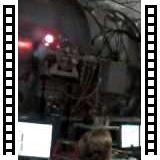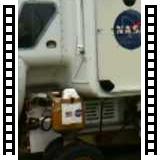 | How to don an EVA suit in NASA's new rover (2011-09-27)      How to don an EVA suit in NASA's new rover
|
 | Plasma Rocket (2011-05-29)      Plasma test shots from the VASIMR VX-100 prototype plasma rocket housed at NASA's Johnson Space Center. The video is slowed down to 1/2 speed. In general, these types of thrusters (ion thrusters, Hall thrusters, and VASIMR) take advantage of extremely high exhaust velocities and generally have the ability to operate continuously for months. Although the thrust is much lower than a chemical rocket, the ultimate speed and/or payload fraction delivered is generally much higher. A new higher power rocket (VX-200) is being constructed and will be tested in a new vacuum chamber that is large enough to drive a full size school bus into (with room to spare). The Variable Specific Impulse Magnetoplasma Rocket (VASIMR) is now operated by the Ad Astra Rocket Company, created by former astronaut Dr. Franklin Chang-Diaz (7 Space Shuttle flights). Caption: 1st picture: front view of VX-100 2nd picture: back of vacuum chamber, which houses a translation stage for plasma diagnostics 3rd picture: VASIMR command center 1st video: pneumatic Langmuir probe 2nd video: 10-collector flux probe 3rd video: swinging flux probe (windshield wiper probe) 4th video: large plasma reaction paddle 5th video: small plasma reaction paddle The small plasma reaction paddle has the same diameter and weight as a US half dollar and is made out of titanium. Now featured in Iron Man 2. Ad Astra Rocket Company www.adastrarocket.com More pictures of the last shot at: www.plasmaben.com/VASIMR
|
 | Plasma Sensors Glowing Red Hot in VASIMR Exhaust, lights off (2011-05-31)      After being exposed to the full power VASIMR exhaust for ~5 seconds, several plasma diagnostics can be seen glowing red hot after the shot, even with the interior lights on! Based on the color of these glowing sensors, we estimate the sensor temperature to be ~1000 degrees C. The plasma exhaust temperature is ~1000000 degrees C. Ad Astra Rocket Companys VASIMR® VX-200 rocket prototype reached its highly-coveted 200 kW maximum power milestone at 11:59 am (CST) September 30th 2009 in tests conducted at the companys Houston laboratory. The DC power trace actually exceeded the design requirement by 1 kW and exhibited the clear signature of a well established plateau at peak power. The achievement comes after an intense experimental campaign that began in April 2009 when the engine was fitted with a powerful low temperature superconducting magnet, a critical component that enables VASIMR® to process large amounts of plasma power. The electrical power processing is accomplished using high efficiency, 95%, solid state RF generators built by Nautel Ltd of Halifax, Canada. Demonstration of a 200 kW capability was required to validate, with full scale performance data, the design of the VF-200-1 already underway. The VX-200 turns out to exceed the expected power density of VF-200-1 by about 25%, so this is a robust demonstration of the technology. The VF-200-1 is the first engine that the company plans to fly in space, and it is presently working with NASA to effectuate inspace ...
|
 | Record Power Level For The VASIMR VX-200i, HD (2011-05-29)      This is a record power level test firing in a series of experiments with the VASIMR VX-200 plasma rocket prototype. The rocket's 1st stage (a Helicon plasma source) was fired at 30 kW using a state-of-the-art solid state RF power supply, and the rocket's 2nd stage was fired at 149 kW using a second solid state RF power supply. Argon gas was used as the propellant, and gives a distinctive purple/blue/UV glow. The second half of the video is slowed down to 1/10 speed during the firing of the second stage. The plasma diagnostics that can be seen in this video are situated on an xy motion stage capable of moving side to side 200cm and in an out 500cm with 0.5mm precision. Because of the extreme temperatures and heating within the plasma exhaust, the diagnostics are all constructed out of refractory metals, high temperature ceramics, or graphite (or all three). The rocket and everything else seen in this video is located within a vacuum chamber, used to simulate the vacuum environment of space. The VX-200 is the precursor to the VF-200, a flight demonstration unit that is intended to fly on the International Space Station (ISS). www.nasa.gov www.adastrarocket.com
|
 | Scientists Firing The VASIMR Plasma Rocket (2011-05-29)      This video shows what it's like to fire the VASIMR plasma rocket, the highest power steady-state electric propulsion device in the world, located in Houston TX. Video was taken with the POV.1.5 camera which sports a wide angle lens. Two scientists sit at the command and control computer, and one scientist observes the exhaust plume. The VASIMR VX-200 rocket is located within a vacuum chamber, which simulates the vacuum of space. The cryo-compressors for several vacuum cryo-pumps can be heard in the background. When the rocket fires, valves for liquid nitrogen can be heard opening, which is accompanied by a hiss of gaseous nitrogen. The blue flashing light indicates that the VX-200 superconducting magnet is energized, and the red flashing light indicates that the electrical power for the rocket is enabled. Ad Astra Rocket Companys VASIMR® VX-200 rocket prototype reached its highly-coveted 200 kW maximum power milestone at 11:59 am (CST) September 30th 2009 in tests conducted at the companys Houston laboratory. The DC power trace actually exceeded the design requirement by 1 kW and exhibited the clear signature of a well established plateau at peak power. The achievement comes after an intense experimental campaign that began in April 2009 when the engine was fitted with a powerful low temperature superconducting magnet, a critical component that enables VASIMR® to process large amounts of plasma power. The electrical power processing is accomplished using high efficiency ...
|
 | Two NASA rovers play in playground (2011-09-27)      Two NASA rovers in playground
|
 | VASIMR at Full Power (2011-05-29)      This video shows the startup of the VASIMR 1st stage over 5 seconds, the increasing power of the second stage over 3 seconds, a plateau of full power operation for 5 seconds, and then rocket shut down. The VX-200 is operating in a 150 cubic meter vacuum chamber, used to simulate the vacuum of space. Ad Astra Rocket Companys VASIMR® VX-200 rocket prototype reached its highly-coveted 200 kW maximum power milestone at 11:59 am (CST) September 30th 2009 in tests conducted at the companys Houston laboratory. The DC power trace actually exceeded the design requirement by 1 kW and exhibited the clear signature of a well established plateau at peak power. The achievement comes after an intense experimental campaign that began in April 2009 when the engine was fitted with a powerful low temperature superconducting magnet, a critical component that enables VASIMR® to process large amounts of plasma power. The electrical power processing is accomplished using high efficiency, 95%, solid state RF generators built by Nautel Ltd of Halifax, Canada. Demonstration of a 200 kW capability was required to validate, with full scale performance data, the design of the VF-200-1 already underway. The VX-200 turns out to exceed the expected power density of VF-200-1 by about 25%, so this is a robust demonstration of the technology. The VF-200-1 is the first engine that the company plans to fly in space, and it is presently working with NASA to effectuate inspace testing in late 2013 on the ...
|
 | VASIMR Fires At Full Power For 15 Seconds (2011-05-29)      This video shows the VASIMR VX-200 during a 30 second firing of it's first stage, and a 15 second firing of it's second stage. www.AdAstraRocket.com The Astra Rocket Companys VASIMR® VX-200 rocket prototype reached its highly-coveted 200 kW maximum power milestone at 11:59 am (CST) September 30th 2009 in tests conducted at the companys Houston laboratory. The DC power trace actually exceeded the design requirement by 1 kW and exhibited the clear signature of a well established plateau at peak power. The achievement comes after an intense experimental campaign that began in April 2009 when the engine was fitted with a powerful low temperature superconducting magnet, a critical component that enables VASIMR® to process large amounts of plasma power. The electrical power processing is accomplished using high efficiency, 95%, solid state RF generators built by Nautel Ltd of Halifax, Canada. Demonstration of a 200 kW capability was required to validate, with full scale performance data, the design of the VF-200-1 already underway. The VX-200 turns out to exceed the expected power density of VF-200-1 by about 25%, so this is a robust demonstration of the technology. The VF-200-1 is the first engine that the company plans to fly in space, and it is presently working with NASA to effectuate inspace testing in late 2013 on the International Space Station (ISS). The total power processed by the engine is distributed between its two electromagnetic stages. The first, tested last ...
|

















































